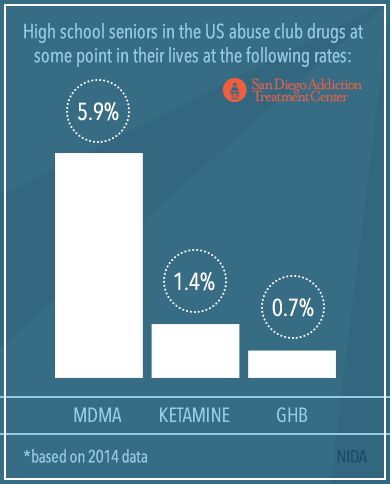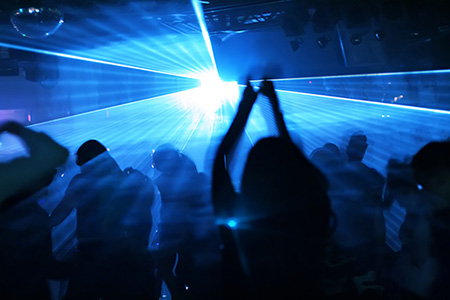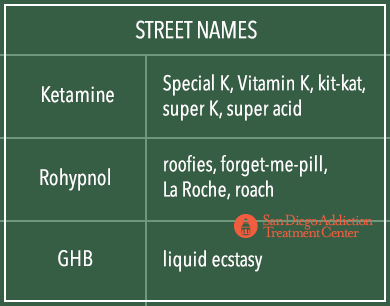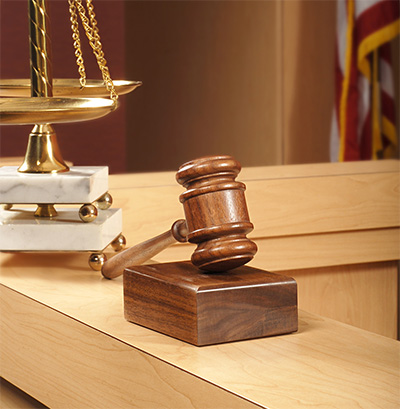Club Drugs Statistics and Addiction Rates in California
Raves, or electronic music dance parties, and clubs are popular places for “club” drugs to be used, and these drugs may be most popular with young adults or even teens.[1] Typically, club drugs include four main drugs: ecstasy (3,4-methylenedioxymethamphetamine or MDMA), GHB (gamma hydroxybutyrate), Special K (Ketamine), and Rohypnol (flunitrazepam), which are all mind-altering in some way.
Some reports also include methamphetamine, or meth, in the club drug category, although generally, meth is considered on its own, possibly due to its high levels of abuse and usage outside of the rave scene. Some may even consider LSD (lysergic acid), PCP (phencyclidine), or other hallucinogenic drugs as club drugs; however, these drugs are not widely used or very common in recent years. High school seniors, or 12th graders, in the United States (based on 2014 data) abuse club drugs at some point in their lives at the following rates:
- MDMA: 5.9 percent
- Ketamine: 1.4 percent
- GBH: 0.7 percent
- Rohypnol: 1 percent abused in the past month (lifetime data not available)[2]

In California, between 2011 and 2013, 2 percent of 9th grade students and 4 percent of 12th graders reported lifetime use of MDMA, while 6 percent of high school seniors admitted to using the drug at least four times.[3] Club drugs may be very dangerous, resulting in toxic overdose, or even death in some cases. All of these drugs make chemical changes in the brain and may disrupt the regions responsible for feeling pleasure, decision-making, impulse control, memory, and reward processing. When drugs are abused at a young age before these brain centers, like the prefrontal cortex, are fully formed, it may increase the risks for developing a substance abuse disorder or addiction later in life.[4]
Ecstasy
 Ecstasy, also called X, hug beans, love drug, E, XTC, and Adam, is a stimulant drug with hallucinogenic properties that increases energy, stimulation, pleasure, and sensations while also speeding up respiration, blood pressure, and heart rate; increasing body temperature; and decreasing the need to eat or sleep. Ecstasy abuse was once rampant, in big cities in particular, although its popularity seems to be waning in recent years. Juvenile arrestees in the San Diego area tested positive for MDMA 47 percent of the time in calendar year (CY) 2011, but only 34 percent in CY 2012.[5] In San Diego County, in 2014, there was only one reported death from MDMA.[6]
Ecstasy, also called X, hug beans, love drug, E, XTC, and Adam, is a stimulant drug with hallucinogenic properties that increases energy, stimulation, pleasure, and sensations while also speeding up respiration, blood pressure, and heart rate; increasing body temperature; and decreasing the need to eat or sleep. Ecstasy abuse was once rampant, in big cities in particular, although its popularity seems to be waning in recent years. Juvenile arrestees in the San Diego area tested positive for MDMA 47 percent of the time in calendar year (CY) 2011, but only 34 percent in CY 2012.[5] In San Diego County, in 2014, there was only one reported death from MDMA.[6]
Raves are popular venues for drug abuse and ecstasy in particular. In Los Angeles County, a New Year’s Eve rave in 2009 led to 18 people seeking emergency department (ED) treatment for MDMA exposure and three of them being admitted to the hospital.[7] Many times, ecstasy is used in combination with alcohol or other drugs, and 13 of these cases in Los Angeles County involved another psychoactive substance.[8]
A version of MDMA often heralded as “pure” is Molly, which is generally anything but pure. It may be mixed with a variety of different toxins, making it extremely hard to know what is in the drug and therefore making it potentially very dangerous. In fact, the Drug Enforcement Administration (DEA) tested 143 Molly seizures between October 2009 and September 2013 and found that only 13 percent of them actually contained MDMA.[9] Both Molly and traditional ecstasy are manufactured in illicit laboratories and may contain a variety of other “additives” the user may be unaware of that may have unintentional and negative side effects.
Ketamine, GHB, and Rohypnol
An anesthetic drug with properties similar to PCP when abused, Ketamine can distort reality, causing hallucinations, amnesia, impaired motor functions, and irregular blood pressure and respiration levels. It may be used as a date rape drug. Called Special K, Vitamin K, kit-kat, super K, and super acid, Ketamine is mostly used legally in veterinary medicine but may also be used recreationally as a club drug illicitly.
Rohypnol is considered illegal in the United States by the Drug Enforcement Administration (DEA), as it may also be used as a date rape drug due to its sedative and amnesia-producing properties.[10] Rohypnol, called roofies, forget-me-pill, La Roche, and roach, is manufactured in a green tablet with blue specks so that when dissolved in drinks at clubs or parties, it may dye the drink blue, although generic versions of the drug may not have the same effect.[11] Rohypnol is a central nervous system depressant and slows down heart rate, body temperature, respiration, and blood pressure. It may commonly be mixed with other drugs or alcohol.

GHB is another central nervous system depressant with euphoric effects that may also be used in bodybuilding. GHB is usually found in liquid form, hence the street name liquid ecstasy. It may also be regularly mixed with other drugs or alcohol when used as a club drug.
Club Drugs and Potential Legal Ramifications

Drug abuse and addiction can create a financial strain on families, as they may result in loss of employment, dropping grades at school, or increased amounts of money spent on drugs, healthcare expenses, and even legal expenses.
Possession or driving under the influence (DUI) of club drugs may lead to troubles with law enforcement in California, as the possession or driving under the influence of any of the main four club drugs is usually considered a misdemeanor offense. Possession with amounts to sell or manufacturing club drugs may be felony offenses.[12]
California does participate in the drug court program with 202 different drug court locations, and special drug courts for youths, as a method to provide treatment to juveniles abusing or addicted to substances instead of sentencing them to jail or prison time.[13] Club drugs may increase the risk of being the victim of a violent crime or sexual abuse as well as increase the risk of being involved in an accident or risky situation. Club drugs may increase sexual risk factors; therefore, the abuse of club drugs may be a contributing factor to the possible contraction of sexually transmitted disease like HIV/AIDS.[14]
Call Now (619) 577-4483
California Club Drug Abuse and Addiction Services
Substance abuse services in the state of California are provided by fee-for-service, or private providers, or publicly funded programs that are run through county agencies and usually free or low-cost for California residents in need. To find a public provider, residents should contact the local county substance abuse services division of the California Department of Health Care Services (DHCS).[15] All treatment providers that offer nonmedical residential care, detox services, counseling, group or individual therapy sessions, and treatment and/or recovery planning are required to be licensed through DHCS. A list of California-licensed providers can be found here listed by county, location, and type of services provided.[16], [17]
Public providers typically ask that individuals go through their primary care doctor for a referral first and will accept clients regardless of their ability to pay for services. Recipients of California’s Medi-Cal, or Medicaid program, may get more information on covered services through the Drug Medi-Cal Treatment Program.[18]
Club drug abuse is treated in three main stages: prevention, treatment, and recovery. Both private and public treatment programs are likely to provide the following types of services:
- Community-based and nonprofit programs may offer educational services for families and individuals, such as the California Adolescent Health Collaborative.[19]
- Programs may be offered in schools to educate children on the dangers of club drug abuse.
- Afterschool programs may help to keep kids from experimenting with drugs by providing an alternative outlet.
- Counseling services may help diffuse stress and improve mental health, thereby decreasing potential drug abuse.
- Detox services safely remove drugs and toxins from the body.
- Intensive outpatient programs require that individuals enter into a structured program that may use both behavioral and medicinal methods during the day; the person returns home each night.
- Outpatient services may include counseling, pharmacological management, group and individual therapy, life skills training, education, parenting classes, family services, and more.
- Residential treatment programs are likely more comprehensive and structured, providing around-the-clock care, treatment, and supervision.
- Transitional services may include sober living homes for those who have completed treatment and may benefit from one more supportive care method before returning home.
- Additional support can be found from peer support services and programs like the ones provided by the nonprofit organization PEERS (Peers Envisioning and Engaging in Recovery Services).[20]
- Self-help recovery groups and 12-Step programs provide a healthy support network for those in recovery.
- Aftercare services may include follow-up sessions, counseling, and family services to offer support for long-term recovery.
Club drugs are not generally considered to be addictive on their own; however, patterns of abuse may create social, economic, personal, legal, physical, and emotional issues. Abuse of substances at a young age may lead to addiction to such substances later on. Preventative, therapeutic, and recovery services are important parts of the California substance abuse treatment sector and help to foster long-term health for individuals, families, and communities.
Citations
[1] (Dec. 2012). “Club Drugs.” National Institute on Drug Abuse (NIDA). Accessed December 3, 2015.
[2] Ibid.
[3] (2014). “California Healthy Kids Survey (CHKS).” WestEd Health & Human Development Program. Accessed December 3, 2015.
[4] (Jan. 2014). “Principles of Adolescent Substance Use Disorder Treatment: a Research-Based Guide.” National Institute on Drug Abuse (NIDA). Accessed December 3, 2015.
[5] (Feb. 2014). “Drug Abuse Patterns and Trends in San Diego County- Update: January 2014.” National Institute on Drug Abuse (NIDA). Accessed December 3, 2015.
[6] Wagner, G. MD. (2014). “2014 Annual Report.” County of San Diego Department of the Medical Examiner. Accessed December 3, 2015.
[7] (Jan. 2010). “Ecstasy Overdoses at a New Year’s Eve Rave- Los Angeles, California.” Centers for Disease Control and Prevention (CDC). Accessed December 3, 2015.
[8] Ibid.
[9] Lerger, D. (Sept. 2014). “Overdoses Attributed to Club Drug ‘Molly’ Increase.” USA Today. Accessed December 3, 2015.
[10] (n.d.). “Drug Fact Sheet Rohypnol.” Drug Enforcement Administration (DEA). Accessed December 3, 2015.
[11] Ibid.
[12] (July 2001). “Club Drug- Crime Classification.” San Diego Police Department Sex Crimes Unit. Accessed December 3, 2015.
[13] (June 2013). “Drug Court Locations in the United States as of June 2013.” National Institute of Justice(NIJ). Accessed December 3, 2015.
[14] Colfax, G., Guzman, R., Mayer, K. (Jan. 2006). “Club Drugs and HIV Infection: A Review.” Oxford Journals. Accessed December 3, 2015.
[15] (2015). “Alcohol and Other Drugs Programs County Directory.” California Department of Health Care Services (DHCS). Accessed December 3, 2015
[16] (2015). “Facility Licensing.” California Department of Health Care Services (DHCS). Accessed December 2, 2015.
[17] (2015). “Alcohol and Other Drugs Programs County Directory.” California Department of Health Care Services (DHCS). Accessed December 3, 2015
[18] (2015). “Drug Medi-Cal (DMC) Treatment Program.” California Department of Health Care Services (DHCS). Accessed December 3, 2015.
[19] (2011). “Health Topics.” California Adolescent Health Collaboration. Accessed December 3, 2015.
[20] (2014). “Our Mission and Vision.” Peers Envisioning and Engaging in Recovery Services (PEERS). Accessed December 3, 2015.
